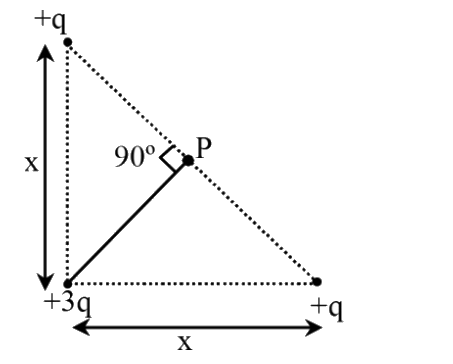Calculate the magnitude of the electric field which can just balance a deuteron of mass 3.2×10−27kg
To calculate the magnitude of the electric field that can just balance a deuteron of mass 3.2×10−27kg, we can follow these steps:
Step 1: Understand the forces acting on the deuteron
The deuteron, which is a nucleus of deuterium, experiences two forces:
- The gravitational force acting downwards, given by Fg=mg
- The electric force acting upwards, given by Fe=qE
Where:
- m is the mass of the deuteron,
- g is the acceleration due to gravity (approximately 10m/s2),
- q is the charge of the deuteron,
- E is the electric field.
Step 2: Set up the equation for balance of forces
For the deuteron to be in equilibrium (balanced), the upward electric force must equal the downward gravitational force:
mg=qE
Step 3: Rearrange the equation to solve for the electric field E
From the equation mg=qE, we can express the electric field E as:
E=mgq
Step 4: Substitute the known values
- Mass of the deuteron, m=3.2×10−27kg
- Acceleration due to gravity, g=10m/s2
- Charge of the deuteron, q=1.6×10−19C
Now substituting these values into the equation for E:
E=(3.2×10−27kg)⋅(10m/s2)1.6×10−19C
Step 5: Calculate the electric field
Calculating the numerator:
3.2×10−27kg⋅10m/s2=3.2×10−26N
Now substituting into the equation:
E=3.2×10−26N1.6×10−19C=2.0×10−7N/C
Step 6: Final answer
Thus, the magnitude of the electric field that can just balance the deuteron is:
E=2.0×10−7N/C
The deuteron, which is a nucleus of deuterium, experiences two forces:
- The gravitational force acting downwards, given by Fg=mg
- The electric force acting upwards, given by Fe=qE
- m is the mass of the deuteron,
- g is the acceleration due to gravity (approximately 10m/s2),
- q is the charge of the deuteron,
- E is the electric field.
For the deuteron to be in equilibrium (balanced), the upward electric force must equal the downward gravitational force:
mg=qE
From the equation mg=qE, we can express the electric field E as:
E=mgq
- Mass of the deuteron, m=3.2×10−27kg
- Acceleration due to gravity, g=10m/s2
- Charge of the deuteron, q=1.6×10−19C
E=(3.2×10−27kg)⋅(10m/s2)1.6×10−19C
Calculating the numerator:
3.2×10−27kg⋅10m/s2=3.2×10−26N
E=3.2×10−26N1.6×10−19C=2.0×10−7N/C
Thus, the magnitude of the electric field that can just balance the deuteron is:
E=2.0×10−7N/C
Topper's Solved these Questions
- ELECTROSTATICSBOOK - DC PANDEY ENGLISHCHAPTER - ELECTROSTATICSEXERCISE - Example Type 5
5 Videos
- ELECTROSTATICSBOOK - DC PANDEY ENGLISHCHAPTER - ELECTROSTATICSEXERCISE - Example Type 6
4 Videos
- ELECTROSTATIC POTENTIAL AND CAPACITORSBOOK - DC PANDEY ENGLISHCHAPTER - ELECTROSTATIC POTENTIAL AND CAPACITORSEXERCISE - (C) Chapter exercises
50 Videos
- GRAVITATIONBOOK - DC PANDEY ENGLISHCHAPTER - GRAVITATIONEXERCISE - All Questions
135 Videos
Similar Questions
Calculate the electric field strength which is required to just support a water drop of mass 10−3 kg and having a charge 1.6×10−19C.
View SolutionCalculate the magnitude and direction of the electric field at a point P which is 30 cm to the right of a point charge Q=−3.0×10−6C
View SolutionA beam of charged particle, having kinetic energy 103eV, contains masses 8×10−27kgand1.6×10−26kg emerge from the end of an accelerator tube. There is a plate at distance 102m from the end of the tube and placed perpendicular to the beam. Calculate the magnitude of the smallest magnetic field which can prevent the beam from striking the plate.
View SolutionFind the magnitude of the electric field at a point 4 cm away from a line charge of density 2×10−6Cm−1.
View SolutionImagine a short diploe at the center of a spherical surface. If the magnitude of the electric field at a certain point on the surface of he sphere is 10NC_1 then which of the following cannot be the magnitude of the electric field anywhere on the surface of the sphere?
View SolutionA particle having a charge+3×10−9C is placed in a uniform electric field directed toward left. It is released from rest and moves a distance of 5 cm after which its kinetic energy is found to be 4.5×10−5J.
(a) Calcnalate the work done by the electrical force on the particle
(b) Calculate the magnitude of the electric field.
(c) Calculate the potential of starting point with respect to the end point of particle's motion.
View SolutionThe magnitude and direction of the electric field at point P can be best represented by

View SolutionCalculate the electric field strength required just to support a water drop of mass 10−7kg having a charge 1.6×10−19C
View SolutionA proton goes undflected in a crossed and magnetic field (the fields are perpendicular to each other) at a speed of 2.0X105ms−1. The velocity is perpendicular to both the fields. When the electric field is switched off, the proton moves along a circle of radius 4.0 cm. Find the magnitudes of the electric and the magnetic fields. take the mass of the proton =1.6X10−27 kg.
View SolutionCalculate the electric field intensity which would be just sufficient to balance the weight of a particle of charge −10μC and mass 10 mg. (Take g=10ms2)
View Solution
